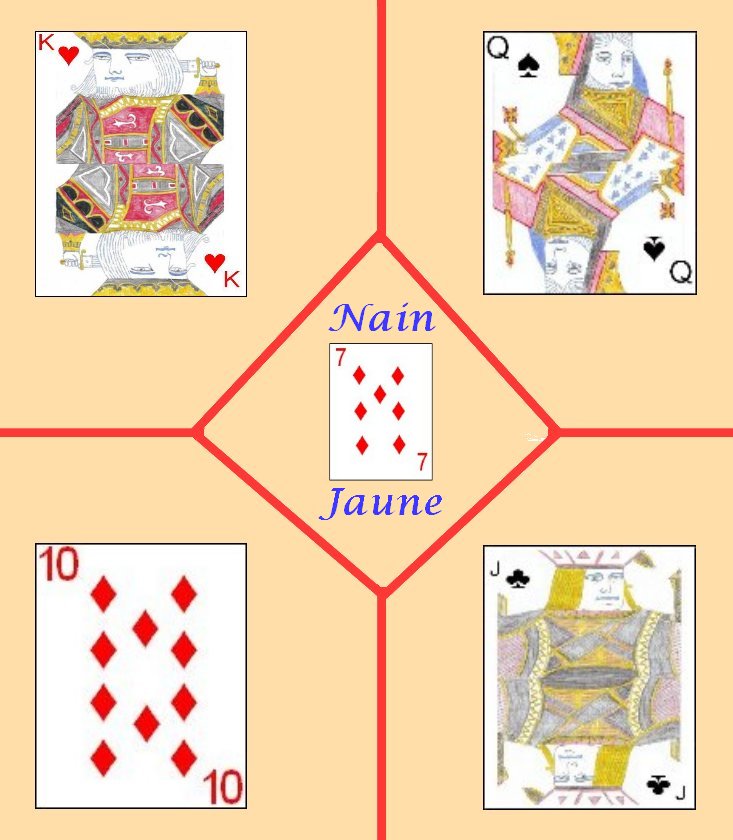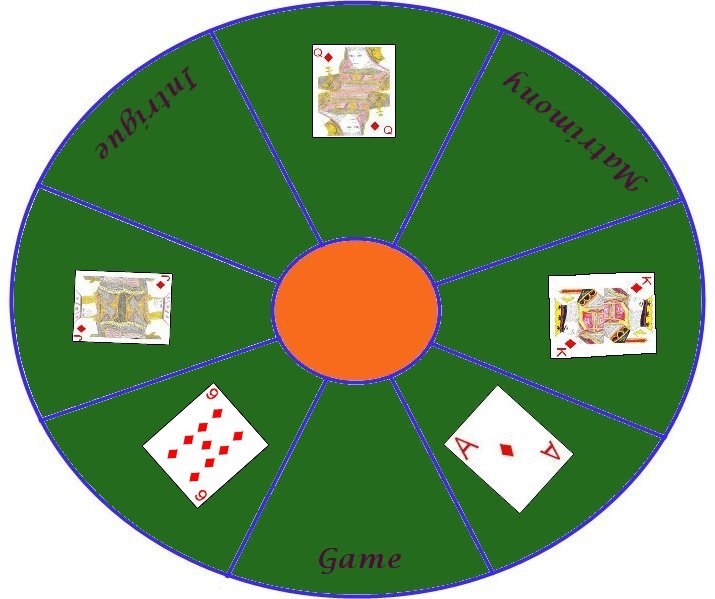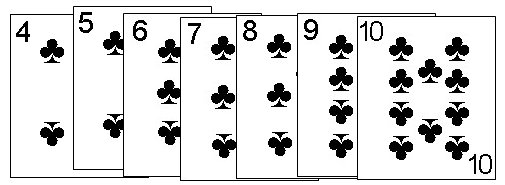 Le Jau Du Nain Jaune is an antique French game similar in vein to Michigan and some of it's variants. In English the game's name translates to Game of the Yellow Dwarf and gets it's name from a classic French children's story. This appears to be one of the oldest games of this type to still be played.
Le Jau Du Nain Jaune is an antique French game similar in vein to Michigan and some of it's variants. In English the game's name translates to Game of the Yellow Dwarf and gets it's name from a classic French children's story. This appears to be one of the oldest games of this type to still be played.
Nain Jaune is designed to be played by three to six players using the standard 52 card deck. The ranking of the cards in this deck are as follows (from low to high); Ace, 2, 3, 4, 5, 6, 7, 8, 9, 10, Jack, Queen, King. In addition to the deck, the game uses a special board and a number of chips or tokens. The special board can sometimes be found in stores, but it can also easily be created. We have also provided a printable version of the board which can be accessed from this link. The board consists of five compartments, each labeled or with a depiction of
a specific cards from the deck; 10 of Diamonds, Jack of Clubs, Queen of Hearts, King of Spades and Seven of Diamonds. The chips used can all be of one uniform color representing one unit each or, different colors, sizes or styles of chips can be used representing one, five and twenty-five units.
Determination of seating positions and first dealer can be done in a variety of ways with drawing cards from a face-down shuffled deck being a common method. Whichever player draws the highest card would be the first to select a seat, and the remaining players taking seats in the order of card ranking. The player with the highest card of all becomes the first dealer. In the event two or more players draw cards of the same denomination, the tying players should each draw an additional card to determine the ranking amongst all those who tied.
To begin the hand, each player should be given an equal number of chips. This number can vary depending on how long the players want the current game to continue. 50 chips would
constitute a fairly short game and 100 a longer one. At the beginning of each hand, the players must each distribute the following number of chips to the indicated sections of the board:
| Layout Marking | Chips to be Placed on Section |
|---|
| 10 of Diamonds | 1 |
| Jack of Clubs | 2 |
| Queen of Hearts | 3 |
| King of Spades | 4 |
| 7 of Diamonds | 5 |
After the distribution of the necessary chips, the dealer can then begin dealing the hand. He should deal the cards in a clockwise rotation face down and one by one to each player. The number of cards received per player is dependent on the number of players. In addition, several cards are not used during the hand and set aside before play begins. The following chart shows the number of cards dealt to each player and the number of cards not used:
| Number of Players | Cards Received per Player | Number of Cards not Used |
|---|
| 3 | 15 | 7 |
| 4 | 12 | 4 |
| 5 | 9 | 7 |
| 6 | 8 | 4 |
| 7 | 7 | 3 |
| 8 | 6 | 4 |
After all cards have been distributed, the player to the immediate left of the dealer has the first turn. To begin, he selects any card from his hand and places it face up on the table. He may continue playing cards on top of this card as long as he can play the next highest card on the last. The cards played can be of any suit. He continues to play to the sequence until he has no more legal plays. When this occurs, he simply states "Pass" and the turn moves to the next player in a clockwise rotation. This player than attempts to continue playing cards to continue the sequence. If unable to play he simply states "Pass" and the turn rotates to the next player. If a player has a legal play on his turn he must make the play. When a player, on his turn plays a card that matches exactly (in rank and suit) one of the cards represented on the layout he may take all chips found on that section of the layout and continues playing as able.
When the King is played to a sequence this ends the current sequence. The player who played the King then selects any other card from his hand to begin a new sequence. If all other players pass after a play, the player who played the last card may also begin a new sequence, starting with any card from his hand.
The game continues in this manner until one player runs of out cards in his hand, winning the hand. This player then collects a number of chips from the other players based on the denomination of the cards found in
their hand. The following chart shows the number of points collected for the cards found remaining in their hand:
| Card in Hand | Chips Required |
|---|
| Ace | 1 |
| 2 to 10 | Value Marked on Card |
| Jack, Queen, King | 10 |
In addition, if a player has any of the special point scoring cards (as mentioned previously) remaining in his hand corresponding to a space on the layout, he must add chips from his own stock to double the current number of chips in that position.
At the end of each hand, all players must again supply the required chips on each section of the layout. After each hand the deal rotates to the next player in a clockwise rotation.
If a player manages to play all of his cards on his first turn (called Grand Opera) he would receive the normal chips required for cards left in his
opponents' hands, but would also receive all chips remaining on the center layout after all his opponents made the required payments for any of these cards remaining in their hand.
In the event a player does not have enough chips remaining in his stock to add to the center layout or give to another player based on his cards, the game ends. The player with the most chips is declared the winner.
Variations and Optional Rules
 Pope Joan: This is a similar game to Nain Jaune, but of English origin. It is somewhat newer than Nain Jaune, but plays using a similar concept.
Pope Joan: This is a similar game to Nain Jaune, but of English origin. It is somewhat newer than Nain Jaune, but plays using a similar concept.
This game, which is designed for three to eight players, uses a standard 52 card deck with one card removed, the eight of Diamonds. The ranking of the cards in the deck are as follows (from low to high); 2, 3, 4, 5, 6, 7, 8, 9, 10, Jack, Queen, King. As in Nain Jaune, when playing this game, each player should be provided an equal number of chips or tokens (called fish). A special board, usually circular in shape, is also used when playing this game. Very fancy versions of this board, in tray form, can sometimes be found for playing the game, but a player can also create his own or use the printable version which can be found at this link.
Selection of seating positions and first dealer can be done in the
same manner as for Nain Jaune. Once determined the first dealer thoroughly shuffles the cards and begins the deal. When dealing, the dealer would deal one more hand than actual participants in the game. This extra "dead" hand would be dealt immediately before the dealer gets his own cards in each round of dealing. The entire deck used for the game should be dealt as far as they will deal out. Some players may receive extra cards which is acceptable. The last card dealt to the dead hand should be exposed, determining a trump suit for the hand. Before play of the hand, the dealer must also "dress the board" which consists of placing a certain number of chips on each compartment or section of the layout; six chips in Nine of Diamonds, two chips in Matrimony, two in Intrigue, one in Game, one in Ace, one in King, one in Queen and one in Jack. If the initial trump card exposed is an Ace, King, Queen or Jack the dealer immediately collects all chips from the compartment on the board corresponding to the card. Similarly, if the Nine of Diamonds is the card exposed, the dealer may collect all chips in that compartment.
After dressing the board, the player to the dealer's immediate right begins play. He begins by playing his lowest card of any suit to the table. He may continue playing additional cards as long as he has the next card in numerical sequence to the one last played of the same suit. Once he can no longer play any additional cards he states "pass". Whichever player who has the next card in his hand which can be played to the sequence in the same suit may then begin playing cards to the sequence until unable to continue the sequence in the same suit. This continues until either a King is played (the highest card of any sequence) or no player can continue the next card in the current sequence. In the event a King is played, the player who played the King may then begin a new sequence. As previously, he may play a card from any suit, but he must play the lowest card of that suit, with play continuing to the sequence as each player is able.
In the event that no player can continue an ongoing sequence, the player who played the last card to the current sequence may start a new sequence by playing his lowest card of any suit to the table to begin a new sequence. This continues until one player manages to play his last card to the table, winning the hand. At this point the hand ends, and each player must give the player who ran out of cards one chip for each card still remaining in their own hand. The player who has the Nine of Diamonds is exempt from this requirement, however.

During play of the hand, when certain cards are played corresponding to spaces on the gameboard, the player playing the card or cards collects all chips from that compartment, as follows:
- Nine of Diamonds (Pope)
- When a player, during his turn, manages to play the Nine of Diamonds, he collects all chips found in this compartment.
- Matrimony
- When the same player, on his turn, legally plays the King and Queen of the trump suit, he may collect all chips in this compartment.
- Intrigue
- A player who, on his turn, plays both the Jack and Queen of the trump suit collects all chips from this compartment.
- Ace
- A player who plays the Ace of the trump suit on his turn is entitled to collect all chips in this compartment from the board.
- King
- A player who is able to play the King of the trump suit during his turn may collect all chips in this compartment.
- Queen
- Playing the Queen of the trump suit allows a player to collect all chips in this compartment from the board.
- Jack
- A player who plays the Jack of the trump suit is entitled to collect all chips from this compartment on the board.
- Game
- The first player to play his last card during a hand collects all chips from this compartment.
After a player wins the hand, the deal rotates in a clockwise rotation. The new dealer then must then dress the board, adding the required number of chips to each compartment as indicated. Any uncollected chips left on the board remain on the board until won by a player.
If a player manages to play his entire hand on his first turn during a hand (called Grand Opera) in addition to the normal chips collected from the other players, he may also take all chips currently on the board.
The game normally continues for a specified number of hands or when one player runs out of chips. At this point, the player with the largest number of chips is declared the winner of the game.
Copyright © 2015 CatsAtCards.com. All rights reserved.

 Le Jau Du Nain Jaune is an antique French game similar in vein to Michigan and some of it's variants. In English the game's name translates to Game of the Yellow Dwarf and gets it's name from a classic French children's story. This appears to be one of the oldest games of this type to still be played.
Le Jau Du Nain Jaune is an antique French game similar in vein to Michigan and some of it's variants. In English the game's name translates to Game of the Yellow Dwarf and gets it's name from a classic French children's story. This appears to be one of the oldest games of this type to still be played.

 Pope Joan: This is a similar game to Nain Jaune, but of English origin. It is somewhat newer than Nain Jaune, but plays using a similar concept.
Pope Joan: This is a similar game to Nain Jaune, but of English origin. It is somewhat newer than Nain Jaune, but plays using a similar concept.
